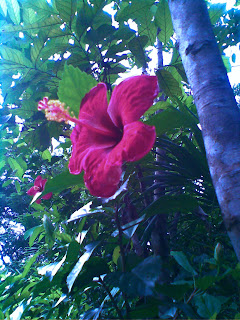Hibiscus is Katueanga and Ylang-ylang is Daeanghilang
 |
| Behold, the Katueanga! |
"Tay, sueanga ako makaron", my daughter requested me. What she meant to say is that I send her off and in my tongue, it should be put, "Tay, hatdan ako hu." The other day, she inquired when I asked her to cook rice, "Hay sin-o ma-obra it kaeayo?" Her mind is constructing the question in English and literally translated it, unaware of the idioms, "Who will make fire?"
It is sad to note that the younger generation is becoming alienated from our native tongue. It is sadder to discover that their minds work and construct images in weltanschauung far different from our own. Even then, I got some opportunity especially when there are power interruptions and the kids are forced to huddle together on my lap asking for stories or some old folk songs to sing. From my point of view, brownouts are blessings in disguise, freeing us from our dependence of electronic gadgets that otherwise steal us our attention. For instance, the other night, we celebrated the blackness with a song I heard sung by my lola several decades ago. I improvised though to keep the kids interested:
"Si AV nga maitom-itom, angay gid sa baeay nga butong. Tumindog, yumuhom-yuhom matsa bueak it Katsubong.
"Si Vida nga maputi-puti, angay gid sa baeay nga tapi. Tumindog, kumiri-kiri, matsa bueak it Kamantigue.
And sure enough, there were series of questions raised by the curious girls. "Anu, Tay, do Katueanga?" Of course, most of us Aklanon seldom heard of that word for we've gotten used to call that flower, "Gumamela" or Hibiscus. In olden times, Katueanga is almost synonymous with red for there was no other varieties then. Today, one could feast on the many colors of hibiscus."Si Vita nga mapuea-puea, angay gid sa baeay nga tabla. Tumindog, humiya-hiya, matsa bueak it Katueanga."
 |
| A seafood pakbit with Anaea-taea herb |
In my interactions with older people in the Ilaya (the mountainous region of Balete) I've managed to document some words we seldom used today. Let me list down some of them here:
- Anaea-taea - n., refers to a seasonal herb that thrives along moistened ground; tastes like mint and smells like anise
- Daeanghilan - n., Ylang-ylang
- Deawidaw - n., a variety of humming bird (Antuyamis) thriving in upper and cooler region. With prominent royal blue feather on its chest. Sighted in Agtawagon.
- Oeangkas - n., a minuscule mountain crab boring on moistened ground; most attractive for its bright red pigmentation; There are a lot of it along the trail to Benitinan.
- Sum-ean - n., a dry wood with an ember in it and kept in every house's hearth in mountainous region
- Taeagbasan - n., a tin can where clean rice is kept; rice canister
- Tagwatihot - n., another variety of humming bird in mountainous region. Often seen near abaca plantation; Notable for its red crested feathers and a very acrobatic flights.


Comments
Post a Comment